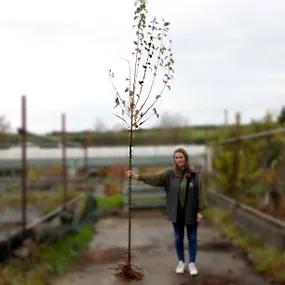Evereste Crab Apple, Large Trees

The details
- Native. Pink buds, white flowers, orange fruit.
- Gold autumn colour.
- Max. Height: 6m
- Bareroot Delivery: Oct-Mar.
- RHS Award of Garden Merit
Recommended extras
Description
Malus Evereste: Bareroot Evereste Crab Apple Trees in Standard Sizes
Evereste crab apple trees are so floriferous that you can hardly see the branches under all the blossom. The dark pink buds open into mostly white blooms, with some clusters keeping a bit of a pink tinge. These mature into a big crop of small, yellow-orange fruit that are perfect for crab apple jelly, apple sauce or for pressing into a mixed cider brew. The glossy green leaves turn rich shades of gold in the autumn.
A tidy upright plant that become semi-weeping under the weight of crabs, she can reach a height of about 6-8 metres.
Browse our variety of crab apple trees or our full range of ornamental garden trees.
Delivery season: Crab apple trees are delivered bareroot during late autumn and winter, approximately November-March inclusive.
Choosing a size: Small trees are cheaper, easier to handle and more forgiving of less than ideal aftercare, so they are best for a big planting project. If instant impact is your priority, or if you are only buying a few plants for use in a place where it is convenient to water them well in their first year, then you may as well use bigger ones. All our bareroot trees are measured by their height in centimetres above the ground (the roots aren't measured).
Features:
- Height: 6-8m
- Soil: Any well drained
- Use: Specimen, small gardens
- Colour: Dark pink buds, mostly white flowers in April-May
- Recommended by Monty Don
- Fruit remain on the branch into winter, or are good for cooking
- RHS Award of Garden Merit
- Bareroot delivery only: November-March
Growing Evereste Crab Apple Trees
Any well drained soil. This is a very tough tree that will do well beside a road in the inner city. Crab apples in general perform well on poor soil if you improve it a bit with compost, then mulch yearly. They love heavy clay on sites that are well drained.
Full sun is ideal if you want to harvest the fruit, but partial shade is fine if you plan to leave them as decoration.
When your new tree is establishing, it is best to remove fruitlets from the ends of the branches after flowering to prevent them from bending the branches.
Planting Instructions
Notes on planting Malus Evereste:
Crabapples are tough plants that thrive in any moderately fertile soil. They tolerate shade well, although we recommend planting them in full sun to get the best display of flowers and fruit. Although a moist, well drained site is ideal, crabapples like heavy clay and don't mind a bit of waterlogging in winter.
They won't grow in deep shade and may struggle in very poor dry soil.
Prepare your site before planting:
It is good to dig over the site where you plant a tree several months in advance. Kill the weeds first: for tough weeds like nettles, brambles and ground elder, you will usually need a weed-killer to get rid of them. When you dig the soil over, remove stones and other rubbish and mix in well rotted compost or manure down to the depth of about 2 spades.
Watch our video on how to plant a tree for full instructions.
Remember to water establishing trees during dry weather for at least a year after planting.
Tree Planting accessories:
Prepare your site for planting by killing the weeds and grass.
You can buy a tree planting pack with a wooden stake & rubber tie to support the tree and a mulch mat with pegs to protect the soil around the base of your tree from weeds and drying out.
We suggest that you use mycorrhizal "friendly fungi" on the roots of all newly planted large trees: if your soil quality is poor, we strongly recommend it.
You can also improve your soil with bonemeal organic fertiliser.
Did You Know?
Bred in France in the late 1970's at INRA, the Institut National de la Recherche Agronomique (which is now INRAE) and released in the UK in 1980, it is allegedly named after one Mademoiselle Eve Reste, but we suspect that might be a bit of a joke on top of a pun. Reste is a real but rare French surname, and Eve reste means "Eve stays". This variety's fruit remain on the branches for an exceptionally long time (it is also called Perpetu), which brings us to the original Eve leaving the garden of Eden over that unfortunate business with picking and eating the fruit of the Tree of Knowledge of Good and Evil (it was probably a fig, rather than an apple, but that's another story).
It won an RHS Award of Garden Merit in 1993, and Monty Don likes it so much that he put four in his Paradise Garden at Longmeadow.
Standard trees are measured by their girth in centimetres 1 metre above ground level: their trunk's waist measurement. Unlike sapling trees and hedge plants, standards aren't measured by their height, which will vary quite a bit both between and within species.
So, a 6/8cm standard tree has a trunk with a circumference of 6-8cm and an 8/10 standard has a trunk 8-10cm around. This measurement makes no difference to the tree's final height.
On average, standard trees are 2-3.5 metres tall when they arrive, but we cannot tell you precisely how tall your trees will be before we deliver them.

 Hero Img.webp)
 Hero Img.webp)
 Img 5.webp)
 Img 2.webp)
 Img 3.webp)
 Img 4.webp)
